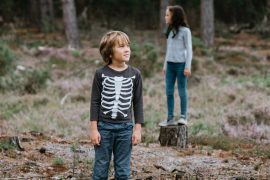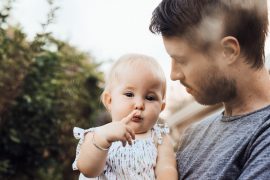What this work clarifies is that children who can depend on a caregiver to act as a “secure base” – to be available and responsive in times of need – gain confidence to explore their world and overcome challenges. This phenomenon is visible in thousands of observations of parents and children in the Strange Situation: When their secure base is present and available, young children explore new environments more; if their secure base leaves the room, their exploration plummets.6 It is also visible on the baseball field: In a telling study of 3- to 12-year-olds racing around a baseball diamond, children ran faster and were less likely to stumble or fall when their parents were available and responsive, compared to when parents were engrossed in their cell phone.7
In fact, a central function of an effective caregiver, according to John Bowlby, is to provide “a secure base from which to explore,” not one to cling to or hide behind.
It is this confidence in a secure base – a felt sense of trust that someone “has their back” in times of trouble – that gives children the internal resources to grow into successful, autonomous adults.8 In a society that pressures children and adults alike toward hyper-independence, the idea that connection is the ground from which healthy independence can grow is both radical and powerfully transformative.
Now imagine you’re back on the diving board, eyeing the challenge ahead of you with trepidation. But this time, your coach acts as a secure base, saying, “I know it’s scary, and I’m right here with you. You’ve worked hard at this, and I’m confident you’ll be okay, even if you make a mistake. When you’re ready, take a deep breath and go for it! I’ll be waiting to hear all about it when it’s over.”
Notice that the secure base doesn’t “coddle” or let you off the hook – you still have to take the leap into the unknown.
But the experience is altered: You are not alone, and there is a spreading sense of strength, warmth, and confidence in that knowledge. You are supported, calmed by this person’s presence, assured of being connected to something beyond your own fear.
We can be this person for our children as they stand on their own diving boards, ready to take the next leap into starting preschool, or standing up to a bully, or trying out for the school play, or going away to college. When we feel the familiar urge to push, we could instead ask, “What would a secure base do?”
References:
[1] Watson, J.B., & Watson, R.A. (1928). Psychological care of infant and child. New York: W.W. Norton & Co.
[2] Bowlby, J. (1969/1982). Attachment and loss: Vol. 1. New York: Basic Books.
[3] Harlow, H.F. (1958). The Nature of Love. American Psychologist, 13, 673-685.
[4] Fox, N., Nelson, C., & Zeanah, C. (2017). The effects of psychosocial deprivation on attachment: Lessons from the Bucharest Early Intervention Project. Psychodynamic Psychiatry, 45, 441-450.
[5] Rutter, M. (2006). The Promotion of Resilience in the Face of Adversity. In A. Clarke-Stewart & J. Dunn (Eds.), The Jacobs Foundation series on adolescence. Families count: Effects on child and adolescent development (pp. 26-52). Cambridge University Press.
[6] Ainsworth, M., Blehar, M.C., Waters, E., & Wall, S. (1978). Patterns of attachment: A psychological study of the Strange Situation. Hillsdale, NJ: Erlbaum.
[7] Stupica, Brandi. (2016). Rounding the bases with a secure base. Attachment & Human Development, 18, 1-18.
[8] Sroufe, A.L. (2005). Attachment and development: A prospective, longitudinal study from birth to adulthood. Attachment & human development, 7, 349-67.
Originally published here.
Jessie Stern, Ph.D., is a Developmental Psychologist and a National Institute of Child Health & Human Development Postdoctoral Fellow at the University of Virginia. Her research focuses on how attachment relationships shape human empathy, altruism, health, and wellbeing from infancy to adulthood.
Rachel Samson, M.Psych, is an Australian-based Clinical Psychologist. Rachel specialises in attachment-focused therapeutic interventions and the trait of high sensitivity (sensory processing sensitivity). She is passionate about the interaction of attachment and temperament, and their influence on emotional wellbeing across the lifespan. You can follow Rachel on Instagram and Facebook and visit her website.










